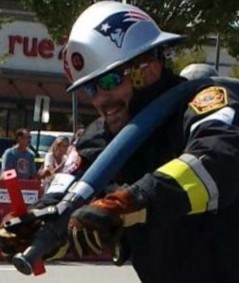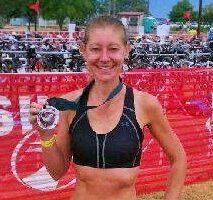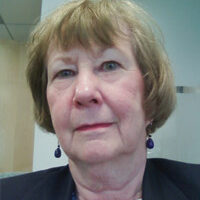Before that day, I was physically fit. I had recently won the National Championship in the Firefighter Combat Challenge. I was a full time Captain with the Fire Department, and the single parent of a 19 year old son, and 16 and 9 year old daughters. I was happy, my kids were happy. Life was good, and crazy, at the same time.
On June 8, 2010, my life changed forever. While responding to an early morning call, I fell 15 feet. I fractured my left leg, and destroyed my left knee. I had surgery in July to stabilize my leg, and it went well. A month later, however, my world began to fall apart. My youngest brother Sean died suddenly of a heart attack at the age of 40. Now, in addition to my injuries, my family and I were crushed with grief over this sudden loss.
Three weeks later I underwent another surgery, and within a week began experiencing pain in my left calf. I followed up with my physician, who sent me for a leg ultrasound. The ultrasound was negative, but I soon learned they are not always accurate. During a physical therapy session, I became short of breath and began sweating profusely. I didn’t think much of it, and since I had a doctor’s appointment that day, I just decided to wait and ask him.
My doctor immediately sent me in for a lung scan. The scan showed multiple pulmonary embolisms in my right lung, and some of them had caused permanent damage. I suddenly found myself the center of attention in the emergency department. I was on oxygen and two blood thinners. I am a paramedic, and I finally understood what was happening. The doctors told me this was often fatal. I felt an overwhelming sense of doom and anxiety.
I was in a state of shock.
After several weeks of being stabilized, it was time to resume the battle to repair my leg.
Due to the extent of damage to my knee, the surgeon recommended a knee replacement, but I had heard of an experimental surgery called autologous chondrocyte implantation (ACI). During this procedure, cartilage is removed, grown in a lab and then injected back into the patient in hope that it will grow. Even after everything I had been through, it seemed better to me than a knee replacement. I had to stop taking blood thinners for the surgery, so I had a permanent IVC filter inserted to prevent any clots that might form from reaching my lungs.
After the surgery, I was unable to walk without assistance for a year. I eventually started back at the gym, slowly. Doctors had determined that I did not have a clotting disorder, but there was a difference of opinion about whether blood thinners were still necessary. I chose to stop taking them.
Then, there was another life-changing event. I was working in my backyard and suddenly felt severe back pain and weakness in my lower extremities. I thought I had injured my back, so I drove myself to the local hospital. They looked at me and took me right in. Within 30 minutes, I was in an ambulance, on my way to a hospital in Boston, on blood thinners and painkillers. When I arrived at the hospital they told me my IVC filter was completely clogged and that I had an 11 inch clot extending from the filter down into my renal and thoracic vein, which was causing the pain. They told me they have never seen such a large clot in a living person and that I needed immediate, and potentially risky, surgery.
Everyone was telling me to have the surgery. To this day I don’t know why, but against medical advice, I chose not to have the surgery. I remained in the hospital for a long time on blood thinners and painkillers. When I left the hospital I could barely walk, and I had to begin another long recovery. In addition to the physical and medical help, I also needed psychological help for the “mental injury” all of this trauma had caused.
It took a lot of determination, but a year later I climbed Pikes Peak in Colorado to spread my brothers ashes. My doctors advised against it, but that’s not who I am. I’m not disabled – I’m a survivor. I don’t pity myself, I am just grateful for the opportunity to continue this great life and to spread the word to others like me.




